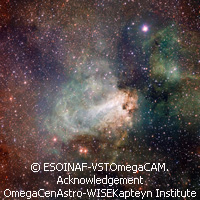The biggest visible light telescope in the world snaps its first images
The new VLT (Very Large Telescope) Survey Telescope (VST) at the Paranal Observatory in northern Chile's Atacama Desert offered the world two new stunning, starry images: Messier 17 (M17), a hotbed of star formation located about 5,500 light-years away in the Sagittarius constellation, and Omega Centauri, the largest and brightest of all known globular star clusters. The VST, the latest addition to the four VLT unit telescopes of the European Southern Observatory (ESO) at the top of Cerro Paranal, is the world's largest wide-field telescope. Its field of view is so large that is able to observe the entire M17 nebula, including its fainter outer parts. The 2.6-metre telescope, with the huge 268-megapixel camera OmegaCAM at its heart, has been designed to map the sky both quickly and with very fine image quality. Furthermore, it is a visible-light telescope that perfectly complements the VISTA infrared survey telescope. 'I am very pleased to see the impressive first images from the VST and OmegaCAM,' ESO Director General Tim de Zeeuw said in a statement. 'The unique combination of the VST and the VISTA infrared survey telescope will allow many interesting objects to be identified for more detailed follow-up observations with the powerful telescopes of the [VLT].' A single picture taken by VISTA has 67 megapixels, and images from OmegaCAM on the VST will have 268 megapixels. The two survey telescopes will produce far more data every night than all the other instruments on the VLTs combined. Together the VST and VISTA will produce more than 100 terabytes of data per year. 'The combination of large field of view, excellent image quality, and the very efficient operations scheme of the VST will produce an enormous wealth of information that will advance many fields of astrophysics,' notes Konrad Kuijken, head of the OmegaCAM consortium. Over the next five years, the VST will conduct three surveys of the southern sky, producing images that will further research on dark matter, the invisible substance that clings to galaxies; dark energy, which is thought to drive the expansion of the Universe; and the evolution of galaxies. 'The VST project has overcome many difficulties but it is now repaying, with its excellent image quality, the expectations of the astronomical community and the efforts of the many people at INAF (Italian National Institute for Astrophysics) involved in its construction,' Tommaso Maccacaro, head of the INAF, said in an ESO press release. 'I am very pleased to see the VST in operation,' he said. The VST project is a joint venture between ESO and INAF in Naples, Italy. More specifically, INAF designed and built the telescope, and ESO was responsible for the enclosure and the civil engineering works at the site.For more information, please visit: European Southern Observatory (ESO):http://www.eso.org/



